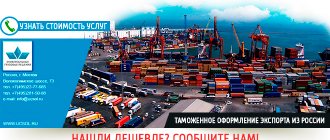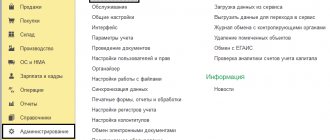The procedure for applying VAT on the sale of non-commodity goods - any movable and immovable property, vehicles, all types of energy - to the countries of the Eurasian Economic Union (Kazakhstan, the Republic of Belarus, Armenia, the Kyrgyz Republic) has its own characteristics. 1C experts tell you how to reflect in the 1C: Accounting 8 version 3.0 program the purchase and sale of non-commodity goods for export to the EAEU countries and confirm the zero VAT rate within 180 days after shipment.
Accounting for export transactions in 1C 8.3 Accounting - step-by-step instructions
Attention! The VAT rate has been changed from 01/01/2019 from 18% to 20% and from 18/118 to 20/120.
The organization entered into an export contract with a foreign buyer LadystyleKz (Kazakhstan) for the supply of non-raw materials in the amount of 15,000 USD.
On February 15, the products “Kate” women’s sandals (1,000 pairs) worth 15,000 USD were exported to the buyer LadystyleKz.
In accordance with the contract, the transfer of ownership of the goods occurs at the moment the goods are transferred by the carrier to the buyer's warehouse. Delivery basis - DAP Almaty.
On February 18, the products were delivered to the buyer’s warehouse.
On February 20, the buyer of Ladystyle Kz transferred 100% postpayment for goods in the amount of 15,000 USD.
Conditional courses for example design:
- February 15, the exchange rate of the Central Bank of the Russian Federation is 62.00 rubles/USD;
- February 18, the rate of the Central Bank of the Russian Federation is 63.00 rubles/USD;
- On February 20, the exchange rate of the Central Bank of the Russian Federation was 69.00 rubles/USD.
Let's look at the step-by-step instructions for processing export operations in 1C 8.3. PDF
| date | Debit | Credit | Accounting amount | Amount NU | the name of the operation | Documents (reports) in 1C | |
| Dt | CT | ||||||
| Sales of finished products for export (EAEU) | |||||||
| Shipment of finished products for export | |||||||
| February, 15 | 45.02 | 43 | 258 356,16 | 258 356,16 | 258 356,16 | Shipment of finished products | Sales (act, invoice) - Shipment without transfer of ownership |
| Issuance of export invoices in foreign currency (VAT rate 0%) | |||||||
| February, 15 | — | — | 15 000 | Issuing invoices for shipment in foreign currency (VAT rate 0%) | Invoice issued for sales | ||
| Sales of shipped products | |||||||
| 18th of Febuary | 62.21 | 90.01.1 | 945 000 | 945 000 | 945 000 | Revenue from product sales | Sales of shipped goods |
| 90.02.1 | 45.02 | 258 356,16 | 258 356,16 | 258 356,16 | Write-off of product costs | ||
| Receipt of payment from a foreign buyer | |||||||
| February 20th | 52 | 62.21 | 1 035 000 | 1 035 000 | Receipt of payment from a foreign buyer to a transit account | Receipt to the bank account - Payment from the buyer | |
| 62.21 | 91.01 | 90 000 | 90 000 | 90 000 | Revaluation of receivables in foreign currency | ||
| Submission of a statistical report to the Federal Customs Service in electronic form | |||||||
| 28th of February | — | — | 15 000 | Submission of a statistical report to the Federal Customs Service in electronic form | Regulated report - Statistical form of accounting for the movement of goods | ||
For the beginning of the example, see the publication:
- Purchase of materials for production of products
Find out about the release of products with the write-off of materials according to specifications (without the subconto Products)
Advantages of Russian companies entering the German market
- High population;
- Highest purchasing power in Europe;
- Highest GDP in Europe;
- Location in the center of Europe and developed transport infrastructure;
- Qualified personnel with knowledge of Russian and German languages.
- More than 3 million Russian-speaking citizens live in Germany;
- Presence on the German market means competitiveness on the global market.
Regulatory regulation
When exporting, a 0% VAT rate is applied, which must be confirmed. To do this, you should collect a package of documents and submit it simultaneously with the VAT return to the Federal Tax Service.
Please note that exports to the EAEU countries (Russia, Belarus, Kazakhstan, Armenia, Kyrgyzstan) differ from shipments to non-CIS countries. The main regulatory document when working with partners from the EAEU is the Treaty on the Eurasian Economic Union dated May 29, 2014 (EAEU Treaty).
Taxation of export transactions is regulated by:
- Appendix No. 18 to the EAEU Treaty - the Protocol on the procedure for collecting indirect taxes and the mechanism for monitoring their payment when exporting and importing goods, performing work, and providing services (EAEU Protocol).
- The Tax Code of the Russian Federation in the part that is not regulated by the EAEU Protocol, as well as in cases where the Protocol makes reference to local legislation.
The moment of transfer of risks from the seller to the buyer according to Incoterms (Incoterms) and the moment of transfer of ownership of goods should not be confused.
The contract must indicate the moment of transfer of ownership, because according to this date:
- the asset is registered with the buyer;
- the buyer becomes indebted to the supplier for payment;
- Revenue in foreign currency is recalculated into rubles if there has been no prepayment.
When exporting non-commodity goods, there are different procedures for applying input VAT deductions depending on when they were purchased:
- until 07/01/2016 - VAT deduction at the time of confirmation of the 0% rate or not confirmation of it, if 180 days have passed for collecting documents, separate VAT accounting is maintained;
- from 07/01/2016 - VAT is deducted in the general manner; separate VAT accounting is not maintained (Federal Law dated 05/30/2016 N 150-FZ).
We will consider the export of non-commodity goods that were purchased and sold after 07/01/2016.
We fill out the VAT return
Submit your VAT return along with the documents. Submit the report at the location of the organization and only in electronic format. Exporters fill out:
- title page - with information about the organization and tax period;
- section 1 - with information about the amounts of VAT to be reimbursed or paid;
- section 4 - with information on VAT amounts with a confirmed zero rate;
- section 5 - with information about tax deductions;
- section 6 - with information on VAT amounts when the zero rate is not confirmed.
Export of finished products in 1C 8.3
In our example, the transfer of ownership of finished products occurs not at the time of shipment, but at the time of delivery of the product to the buyer’s warehouse. Such a shipment is formalized by the document Sales (acts, invoice) transaction type Shipment without transfer of ownership in the section Sales - Sales - Sales (acts, invoices) - button Sales - Shipment without transfer of ownership).
Let's look at the features of filling out the Implementation document (act, invoice) following an example.
Document header
- Counterparty is a foreign buyer with whom a contract has been concluded. Selected from the Contractors directory.
When entering the Contractors of a buyer from the Eurasian Economic Union into the directory, you must provide the following data: PDF
- Country of registration - select KAZAKHSTAN from the drop-down list. Important for auto-filling the tabular part of the document Implementation (act, invoice) ;
- Tax number;
- Reg. number ;
- The TIN is filled out only for a foreign company that has registered for tax purposes in the Russian Federation. This is not our case.
- Agreement is a contract under which mutual settlements are carried out with a foreign buyer.
The agreement with the buyer in foreign currency must be completed as follows:
- Type of agreement - With the buyer ;
- Price in - USD , i.e. the currency in which the contract was concluded;
- Payment in - switch USD , i.e. payment currency.
In the Prices form in the document, the exchange rate is set from the Currency on the date of the document Sales (deed, invoice) .
Tabular part of the document
On the Products , information about the products being shipped is indicated (name, quantity, price, VAT rate, as well as accounting accounts, HS code, item group in the Subconto ):
- Nomenclature - products shipped to a foreign buyer are selected from the Nomenclature .
For goods (products) intended for export, be sure to fill out the following field in the nomenclature card:
- Commodity Nomenclature of Foreign , according to the Decision of the Council of the Eurasian Economic Commission dated July 16, 2012 N 54 - if the product (product) is a raw material , then the card with the Commodity Nomenclature of Foreign Economic Activity code should have the Commodity Commodity .
The unit of measurement of the nomenclature must correspond to that established by law for a given HS code. In our example, the Unit is par .
This is important for filling out the report Statistical form for recording the movement of goods (approved by Decree of the Government of the Russian Federation of June 19, 2020 N 891). The upload file is checked, among other things, for the correctness of the unit of measurement of the item according to the HS code.
- Commodity nomenclature code - the product code can be entered manually by selecting from the Commodity Nomenclature of Foreign Economic Activity Classifier or pre-filled in the item card. Then the value will be inserted into documents automatically.
- Price and Amount - the columns are filled in in currency, since the agreement was concluded in USD.
- % VAT - 0% , the VAT rate applied when selling goods for export.
- Transfer account - account 45.02 “Finished products shipped” is used to reflect movements of shipped finished products when the proceeds from their sale are not immediately recognized in accounting. In our example, this is due to the fact that ownership of the goods does not pass from the seller to the buyer at the time of shipment.
a member country of the EAEU is selected in the Counterparty card in the Country of Registration the following columns will be automatically filled Sales document (act, invoice)
- % VAT with a value of 0%;
- The HS code is a code from the nomenclature card.
Postings according to the document
The document generates the posting:
- Dt 45.02 Kt - shipment of finished products without transfer of ownership at actual cost.
The document is filled out in the currency based on the contract. The amounts in the entries are reflected in rubles. This is due to the fact that accounting in the Russian Federation is carried out in rubles. The value of assets or liabilities in foreign currency is subject to conversion into rubles (clause 4 of PBU 3/2006).
Revenue in accounting and accounting records has not yet been recognized, since there is no transfer of ownership of the products from the seller to the buyer (clause 12 of PBU 9/99, clause 3 of Article 271 of the Tax Code of the Russian Federation).
The tax base for VAT in foreign currency is recalculated into rubles at the rate of the Central Bank of the Russian Federation on the date of shipment, i.e., the preparation of the first primary document addressed to the buyer (clause 3 of Article 153 of the Tax Code of the Russian Federation, clause 5 of the EAEU Protocol).
Control
Calculation of the tax base for VAT
Documenting
The organization must approve the forms of primary documents, including the document for the sale of goods. In 1C, for internal document flow, a consignment note in the TORG-12 form is used.
The form can be printed by clicking the Print button – Consignment note (TORG-12) of the Sales document (act, invoice) . PDF
As a rule, a foreign buyer is issued:
- invoice-proforma;
- invoice;
- invoice (VAT-invoice), etc.
Documents are prepared with translation into a foreign language. Such forms are not implemented in 1C and can be modified independently.
You are getting
- Saving money. We know how to intelligently reduce customs costs.
- Saving time. The customs broker will promptly resolve all issues at each stage of cargo clearance in order to deliver it to Germany.
- Saves nerves. The customs representative will take care of all issues related to customs clearance of goods.
We guarantee information support, consultations with qualified specialists, cargo safety and compliance with delivery deadlines for exported goods from Russia to Germany. Entrust the development of your business to professionals and receive highly qualified services at affordable prices.
Issuance of export invoices in foreign currency (VAT rate 0%)
Despite the fact that a Russian invoice is not required for a foreign buyer and ownership of the products has not yet been transferred, the organization is obliged to draw up an invoice for export sales according to the general rules no later than 5 days from the date of shipment (clause 3 of article 168 of the Tax Code of the Russian Federation , clause 17 of the Rules for maintaining a sales book, approved by Decree of the Government of the Russian Federation of December 26, 2011 N 1137).
It is allowed to draw up not only the SF, but also the UPD (Letter of the Federal Tax Service of the Russian Federation dated 07/06/2016 N ED-4-15/12070).
An invoice for shipped export goods is issued using the Issue an invoice at the bottom of the Sales document (act, invoice) .
The Invoice document issued is automatically filled with data from the Sales document (act, invoice) . Operation type code – “01” Sales of goods, works, services...”.
The invoice was issued in foreign currency, since the transaction is expressed in foreign currency (Clause 7, Article 169 of the Tax Code of the Russian Federation):
If the SF is not transferred to a foreign buyer, then the Checked (transferred to the counterparty) can be left unchecked. The presence of a checkbox is for reference information; it does not affect the movement of the document and the filling out of the purchase and sales books.
SF with a VAT rate of 0% does not by default enter the sales book simultaneously with sales, as happens when shipping on the domestic market. But only at the time of determining the tax base for VAT for export, if (clause 9 of Article 167 of the Tax Code of the Russian Federation):
- export confirmed within / later than 180 days - on the last day of the quarter in which supporting documents were collected;
- export is not confirmed within 180 days - on the last day of the quarter in which the sale took place.
The moment of determining the tax base for VAT is not specified in the EAEU Protocol, therefore, on this issue one should be guided by the Tax Code of the Russian Federation (clause 5 of the EAEU Protocol, clause 9 of Article 167 of the Tax Code of the Russian Federation).
In the Northern Federation, for shipment to the EAEU, it is necessary to indicate the HS code in column 1a “Product type code” (clause 15, clause 5, article 169 of the Tax Code of the Russian Federation, Letter of the Ministry of Finance of the Russian Federation dated October 7, 2016 N 03-07-11/58589). PDF The data will be filled in automatically if the HS code was previously indicated in the nomenclature card and in the tabular part of the Sales document (act, invoice) in the HS Code .
The document does not generate postings according to BU and NU.
Documenting
The Invoice form was approved by Decree of the Government of the Russian Federation dated December 26, 2011 N 1137. It can be printed by clicking the Print document Invoice or Sales (act, invoice ) button. PDF
Schemes of cooperation with us
We offer two working schemes:
1., within the framework of which our company assumes all obligations for the delivery of goods in Germany. We pick up the goods and sell them to your counterparty in our company; in this case, we also take care of delivery to the buyer.
2. . If a German buyer requires your business to be a direct supplier, our company will provide brokerage and consulting services that include:
- Determination of the commodity code according to the EAEU nomenclature of goods for foreign economic activity
- Control of incoming and outgoing documentation
- Registering your company at customs
- Submitting and completing an application on behalf of your company
- If necessary, delivery of goods to the buyer
Our specialists will advise you on all the necessary documents and help at all stages of the export transaction.
Sales of shipped products
Sales of shipped products for export in 1C 8.3 Accounting is prepared with the document Sales of shipped goods in the Sales – Sales – Sales of shipped goods section – Create button.
The document reflects the transfer of ownership of goods based on a previously completed shipment. It is convenient to enter it on the basis of the document Sales (deed, invoice) type of operation Shipment without transfer of ownership .
Let's look at the features of filling out the document Sales of shipped goods using the example.
- Number - the serial number of the document in 1C, assigned automatically when saving the document;
- from - the date of transfer of ownership of the product from the seller to the buyer under the contract. In our example, the date the carrier transfers the goods to the buyer’s warehouse;
- A shipment document is a Sales document (act, invoice) , which was previously issued for the shipment of products without transfer of ownership.
Postings according to the document
The document generates transactions:
- Dt 90.02.1 Kt 45.02 - write-off of production costs;
- Dt 62.21 Kt 90.01.1 - revenue from sales of products, where: the unpaid portion is assessed at the exchange rate on the date of sale from the Currency .
Control
Calculation of the ruble amount of revenue from the sale of finished products for export.
Please note that revenue in foreign currency is converted into rubles at the exchange rate of the Central Bank of the Russian Federation on the date of recognition of income, i.e., sale, but the rate also depends on the payment procedure.
In our example there was no prepayment. Revenue in accounting and accounting records is calculated at the exchange rate on the date of sale (clause 9 of PBU 3/2006; clause 8 of Article 271 of the Tax Code of the Russian Federation).
Tax base for VAT
According to the legislation, the tax base for VAT in foreign currency is recalculated into rubles at the rate of the Central Bank of the Russian Federation on the date of shipment (clause 5 of the EAEU Protocol), the rate on the date of transfer of ownership is not taken into account. Therefore, revenue in accounting and NU may differ from the tax base for VAT.
When converting revenue from foreign currency into rubles for:
- BU and NU rate is applied by the Central Bank of the Russian Federation on the date of the advance and on the date of sale (transfer of ownership) (clause 9 of PBU 3/2006, clause 8 of Article 271 of the Tax Code of the Russian Federation);
- To calculate the tax base for VAT, only the exchange rate of the Central Bank of the Russian Federation on the date of shipment (transfer) of goods is used (clause 3 of Article 153 of the Tax Code of the Russian Federation).
The tax base for VAT is determined at the rate of the Central Bank of the Russian Federation on the date of shipment, so it will differ from the sales amount in accounting and tax accounting in ruble equivalent if:
- there was an advance payment;
- the date of transfer of ownership does not coincide with the date of shipment.
In our example, there was no prepayment, and the revenue in accounting and accounting records does not coincide with the VAT tax base because the USD exchange rate is different on the date:
- shipments - 62 rubles;
- sale (transfer of ownership of products) - 63 rubles.
Income tax return
In the income tax return:
Revenue from the sale of finished products for export is reflected in the income from sales:
Sheet 02 Appendix No. 1:
- page 010 “Proceeds from sales - total”, including: page 011 “revenue from sales of goods (works, services) of own production.” PDF
Learn more about Setting up Accounting Policies in NU
The cost of finished products sold is reflected in direct expenses:
Sheet 02 Appendix No. 2:
- page 010 “Direct costs related to goods sold...”. PDF
Methods of delivering goods to Germany
Geographical proximity, developed transport links and popularity of the destination determine the relatively low cost and many options for transportation from Russia to Germany.
The best method depends on:
- route;
- type of cargo (refrigerated, oversized, dangerous);
- urgency;
- season;
- financial restrictions.
The most popular transport format, which can be used for all types of cargo, is road delivery to Germany from Russia. Trucks from the European part of the Russian Federation arrive in the destination country within 5-10 days.
Sea freight in Germany is usually used for relatively inexpensive bulk cargo, as well as heavy and bulky cargo.
Rail transport is usually used when exporting raw materials to Germany from the regions of Siberia and the Far East.
Express delivery from Russia to Germany, in 2-4 days - by air. Current fares for various routes are available here.
The combination of different types of transport, as well as the use of a container as a transport unit, will not only reduce the costs of loading and unloading, but also optimize logistics costs.
Receipt of payment from a foreign buyer
In our example, postpayment is made. At the time of sale, a receivable from the foreign buyer was formed under Dt 62.21, calculated as of the date of transfer of ownership.
At the moment the buyer repays the debt under the contract in foreign currency, the receivables are revalued at the rate of the Central Bank of the Russian Federation on the day of payment (clause 7 of PBU 3/2006, clause 8 of Article 271 of the Tax Code of the Russian Federation). As a result, exchange rate differences arise.
Receipt of payment from a foreign buyer is registered with the document Receipt to current account transaction type Payment from buyer in the Bank and cash desk section – Bank – Bank statements – Receipt button.
Let's look at the features of filling out the document Receipt to a current account using our example.
Bank accounts must first be filled out : information about the Organization's currency account to which payment is received from the buyer must be entered.
Payment in foreign currency is credited to a transit foreign currency account.
In our example, settlements under the contract are carried out in foreign currency. PDF As a result of selecting such an agreement in the Receipt to Current Account , settlement accounts with the buyer are automatically set in the field:
- Settlement account - 62.21 “Settlements with buyers and customers (in foreign currency)”;
- Advances account - 62.22 “Calculations for advances received (in foreign currency).”
Since payment by the buyer is made in foreign currency, the document states:
- Bank account - a transit currency account in USD, into which funds are received from the buyer;
- Accounting account - “Currency accounts”, is installed automatically when selecting a foreign currency bank account;
- Amount - payment amount in currency according to the bank statement;
- VAT rate — 0%.
Postings according to the document
The document generates transactions:
- Dt Kt 62.21 - receipt of postpayment from the buyer to the transit currency account;
- Dt 62.21 Kt 91.01 - revaluation of receivables in foreign currency.
Control
Calculation of exchange rate differences when revaluing accounts receivable
Income tax return
In the income tax return:
Positive exchange rate differences are reflected in non-operating income: PDF
- Sheet 02 Appendix No. 1 page 100 “Non-operating income.”
Submission of a statistical report to the Federal Customs Service in electronic form
When exporting to the EAEU, the Organization is obliged to submit to the Federal Customs Service (Federal Customs Service) a statistical form for recording the movement of goods (approved by Decree of the Government of the Russian Federation of June 19, 2020 N 891).
The statistical form in the Federal Customs Service is drawn up using the regulated report Statistical form for accounting for the movement of goods in the section Reports - 1C-Reporting - Regulated reports - the Create button - the All tab - the By Recipients folder - the Federal Customs Service folder.
The report is filled out manually by exporters. PDF
The report period must be selected before the report is recorded. If an incorrect period is selected, you must close the report without saving it and then create a new one.
Yellow cells are filled in manually. Data in green cells is calculated automatically based on the information entered into the report.
After filling out the Statistical form for accounting for the movement of goods, you should Write it down , then using the appropriate buttons, the report can be:
- unload,
- check the unloading,
- type,
- send to the Federal Customs Service.
The statistical form is submitted to the customs authorities by the 10th day of the month following the month of shipment or receipt of goods. It can be downloaded from 1C and sent from your personal account on the FCS portal
For failure to submit or untimely submission of a statistical form for recording the movement of goods to the Federal Customs Service, a fine will be charged (Administrative Code of the Russian Federation, Art. 19.7.13):
- for officials - from 10,000 rubles. up to 15,000 rubles;
- for legal entities - from 20,000 rubles. up to 50,000 rub.
Outsourcing services Russia-Germany
- negotiations with the supplier;
- verification and execution of foreign economic contracts;
- development of an optimal scheme for transporting cargo to Germany;
- forwarding services;
- cargo insurance;
- the whole range of customs services.
Our company’s employees will professionally carry out all the necessary procedures to begin transporting goods to Germany as quickly as possible. At the same time, it doesn’t really matter where your organization is located, because we export to Germany from any city in Russia.
The distinctive features of our company are an individual approach to each client, a flexible payment system, speed in cargo clearance, as well as full support of customs clearance transactions and resolution of all related issues.
Calculation of VAT when exporting non-commodity goods to the EAEU
Next, using an example, we will consider different options for calculating VAT on the export of non-commodity goods that were purchased and sold starting from 07/01/2016.
The calculation of VAT on export supplies of non-commodity goods in 1C will differ depending on whether the 0% VAT rate is documented within 180 days or not.
Export confirmed within 180 days
Export not confirmed within 180 days
Previously unconfirmed exports were confirmed later than 180 days
We carry out
- development of a foreign economic contract that will fully satisfy your interests and legal requirements;
- preparation of necessary documents in order to obtain permission to export your goods from the territory of the Russian Federation;
- selection of an acceptable logistics scheme for delivering your cargo to Germany;
- preparation of shipping documents for export registration, as well as customs clearance.
Our organization provides foreign trade services only to legal entities. VED-Service has extensive experience in supplying various equipment, machine tools, building materials, raw materials and rolled metal to Germany. If you plan to regularly export goods to Germany, we can offer you the organization of export delivery exclusively for you.





